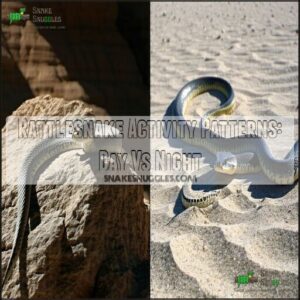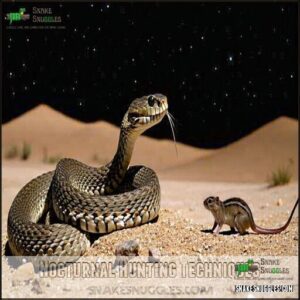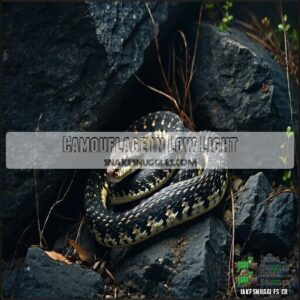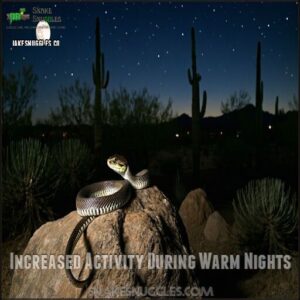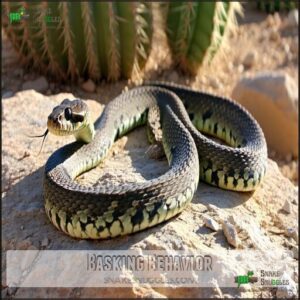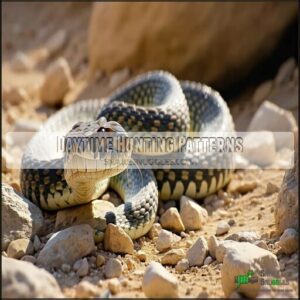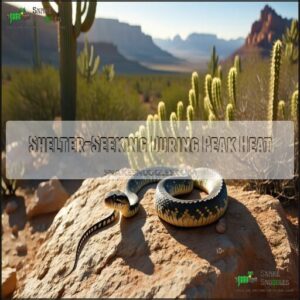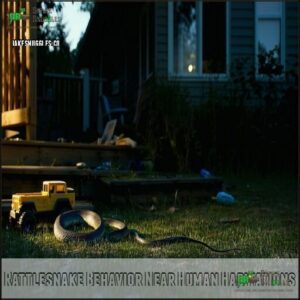This site is supported by our readers. We may earn a commission, at no cost to you, if you purchase through links.

But in the heat of summer, they shift to nighttime activity to avoid the scorching sun—who can blame them? They also love dawn and dusk, those in-between times when temperatures are just right.
Their behavior changes with weather, so you might spot one basking after rain or hiding out on super-hot days. Curious about how to avoid accidental encounters? There’s more to their habits than meets the eye.
Table Of Contents
- Key Takeaways
- Rattlesnake Activity Patterns: Day Vs Night
- Factors Affecting Rattlesnake Movement and Visibility
- Nighttime Rattlesnake Behavior and Adaptations
- Daytime Rattlesnake Activities and Habits
- Seasonal Changes in Rattlesnake Activity Cycles
- Rattlesnake Encounters: Time of Day Considerations
- Environmental Cues Triggering Rattlesnake Activity
- Rattlesnake Behavior Near Human Habitations
- Myths Vs Facts: Rattlesnake Activity Timing
- Safety Tips for Day and Night Rattlesnake Encounters
- Frequently Asked Questions (FAQs)
- How do you keep rattlesnakes away?
- How long do you have once bitten by a rattlesnake?
- Are rattlesnakes active at night?
- When do rattlesnakes come out?
- Are ratsnakes nocturnal or diurnal?
- Do rattlesnakes hunt at night?
- When is the best time of day to avoid rattlesnakes?
- When can you see Rattlesnakes?
- What time of day are rattlesnakes most active?
- How to keep rattlesnakes away?
- Conclusion
Key Takeaways
- Rattlesnakes adjust their activity based on temperature, coming out during the day in cooler months but switching to nighttime in summer heat.
- You’re most likely to see rattlesnakes at dawn or dusk when temperatures are ideal for movement and hunting.
- In hot weather above 90°F, rattlesnakes prefer nighttime activity to avoid overheating during the day.
- Their activity cycles depend on environmental triggers like temperature, humidity, and seasonal changes, not just the time of day.
Rattlesnake Activity Patterns: Day Vs Night
You might be surprised to learn that rattlesnakes don’t stick to just daytime or nighttime—they adjust their activity based on temperature.
When it’s cool, they’re out in the sun, and on hot summer nights, they prefer the cover of darkness.
Temperature-Dependent Behavior
Rattlesnakes are masters of thermoregulation, adjusting their behavior entirely based on temperature. As ectotherms, they rely on the environment to regulate their body heat.
Masters of temperature control, rattlesnakes effortlessly adapt their behavior to match the dynamic rhythm of their environment.
You’ll see them basking on cool mornings to soak up the sun’s warmth. Once it’s above 90°F, though, their behavior shifts—they retreat to shade, avoiding heat like you’d dodge a scorching car seat in summer.
Here’s a quick guide:
| Temperature Range | Activity |
|---|---|
| Below 60°F | Minimal: Hiding in shelters |
| 70-90°F | Ideal: Active hunting, basking |
| Above 90°F | Reduced: Seek shade |
Nocturnal rattlesnakes step out when evenings cool, while diurnal rattlesnakes love spring sunbathing. Their heat-sensing organs even help them locate comfy microclimates—science at its coolest!
Seasonal Variations in Activity
Regarding seasonal variations, rattlesnake activity is all about temperature shifts.
In spring, after winter brumation, diurnal rattlesnakes emerge to soak up the sun and hunt during the day. This is also peak mating time.
As summer temperatures climb, they switch gears to summer nocturnality, hunting through cooler nights and hiding in the shade by day.
Fall brings crepuscularity, with rattlesnakes highly active at dawn and dusk, gorging on prey before winter.
Winter forces them into brumation, gathering in communal dens to escape the cold until spring’s mild weather returns.
Here’s a handy breakdown:
| Season | Activity Pattern | Unique Behavior |
|---|---|---|
| Spring | Diurnal | Basking, daytime hunting |
| Summer | Nocturnal | Shade-seeking by day |
| Fall | Crepuscular | Feeding frenzy at dusk/dawn |
| Winter | Inactive | Brumation in dens |
| Year-Round | Temperature-Dependent | Adapting via climate shifts |
These shifts make rattlesnakes as predictable as the seasons themselves!
Influence of Weather Conditions
Weather conditions greatly influence rattlesnake activity. These reptiles thrive between 70-85°F, basking on rocks.
Above 90°F, they’re nocturnal, hiding in shaded spots by day. Rainfall effects, including high humidity, often bring them out as prey becomes active.
Before storms, barometric pressure shifts send snakes seeking shelter. Temperature extremes like freezing nights or scorching afternoons limit movement.
| Weather Condition | Activity Level | Common Locations |
|---|---|---|
| Mild (70-85°F) | High | Open areas, sunlit rocks |
| Hot (>90°F) | Low (day), High (night) | Shade, nighttime hunting |
| Rainy/Humid | Moderate | Shelters, active hunting |
| Dry & Hot | Low | Hidden in cool retreats |
The table summarizes the relationship between weather conditions and snake activity, highlighting the importance of understanding these patterns to predict rattlesnake behavior. By recognizing the impact of temperature extremes and humidity on snake activity, one can better prepare for encounters.
Nocturnal Vs Diurnal Habits
Understanding rattles activity patterns means taking temperature and season into account.
These reptiles adapt beautifully, switching between nocturnal, diurnal, and crepuscular habits depending on the weather.
They hunt at night during summer, avoid the intense daytime heat, and shift to daytime movements in cooler spring or fall temperatures.
You’ll typically see them most active at dawn or dusk during moderate weather.
Here’s a glance at their behavior:
| Time | Active Period | Temperature (°F) | Risk to Humans |
|---|---|---|---|
| Morning | Basking, hunting | 60-75 | Low |
| Noon | Sheltering | 85+ | Minimal |
| Dusk | High activity | 70-80 | Increased |
| Night | Hunting in summer | 75-90 | Moderate |
Rattlesnake nighttime behavior flourishes when it’s warm, while cooler seasons showcase daytime activity.
Their flexible patterns perfectly blend survival tactics with environmental changes.
Factors Affecting Rattlesnake Movement and Visibility
You’ll notice rattlesnakes adjust their movement based on temperature, habitat, and food sources to survive.
They’re experts at timing their activity to stay warm, avoid predators, and catch prey when conditions are just right.
They’re also skilled at timing their activity to ensure optimal survival conditions.
Habitat Preferences
When choosing home bases, rattlesnakes prefer spots that guarantee safety and access to heat.
Their habitat preferences include rocky benches, dry canyons, or shaded areas under logs or rocks. Sheltering in ideal den locations or hibernacula sites, they adapt their behavior to the environment, whether they’re nocturnal or diurnal.
To better predict their movements, focus on these common snake habitats:
- Rocky areas with cracks or crevices for quick escape.
- Canyons and slopes offering warmth and concealment.
- Man-made zones like sheds or foundations when natural spaces are scarce.
Prey Availability
Rattlesnakes aren’t picky eaters, but their hunting habits revolve around prey availability, which keeps them active both day and night.
They’re skilled at matching their schedule to the buffet nature provides, whether it’s chasing rodents, stalking birds, or surprising lizards.
When rodent abundance peaks—think pocket mice or kangaroo rats—you’ll notice more rattlesnake activity, especially at night when these critters scurry about.
During the day, snakes might focus on bird nesting areas or sunbathing lizards that unknowingly become lunch.
Here’s how prey affects their behavior:
- Rodent Abundance: Drives nocturnal hunts with their heat-sensing pits.
- Lizard Populations: Push daytime activity in warmer months.
- Seasonal Prey: Like insect swarms, influences annual patterns.
Stay alert—nature’s menu shapes their moves!
Thermoregulation Needs
A rattlesnake’s world revolves around temperature. These cold-blooded creatures rely on external heat to regulate their metabolic rate, making their behavior highly temperature-dependent.
You’ll often find them basking on sunny mornings or retreating to shaded burrows during extreme heat. Their heat sensitivity is extraordinary, thanks to specialized pit organs that detect warm or cool spots with precision.
Seasonal sheltering plays a big role too—they seek cooler dens in summer and warmer rocks in cooler months. Ideal temperatures for rattlesnake activity fall between 70-90°F, influencing whether they’re active diurnal sun-seekers or nocturnal hunters avoiding heat.
Every move is a calculated response to their environment, making them highly adaptable to their surroundings, with their behavior being a direct result of their heat sensitivity and the need to maintain an optimal metabolic rate.
Predator Avoidance Strategies
In terms of predator avoidance, rattlesnakes are masters of adaptation. Their camouflage effectiveness helps them blend seamlessly into rocky terrain or desert floors, making it easy to go unnoticed.
If blending in doesn’t work, their defensive mechanisms, like venom or rapid strikes, deter most aggressive predators. To avoid detection, rattlesnakes rely on sensory evasion, detecting ground vibrations with their bodies before predators get too close.
They’re also strategic with habitat selection, choosing concealed spaces like crevices or thick underbrush. At night, their group behavior in dens further reduces risks from predators. Every move they make, whether nocturnal or diurnal, is calculated for survival.
Their survival depends on efficient thermoregulation, unlike snakes that use antifreeze blood proteins.
- Camouflage: Blends perfectly into surroundings.
- Venom Defense: A strong, reliable deterrent.
- Vibration Detection: Early warnings of danger.
- Evasion Tactics: Quick, unexpected movement.
- Warning Rattles: A clear “back off” message.
Nighttime Rattlesnake Behavior and Adaptations
At night, rattlesnakes use their specialized heat-sensing pits to detect prey and navigate in the dark, making them highly efficient hunters when temperatures are warm.
Their ability to camouflage in low light and avoid extreme heat helps them stay active and safe during nighttime hours.
Nocturnal Hunting Techniques
Out under the stars, rattlesnakes turn into master hunters, blending sensory adaptations with precision.
At night, they use heat-sensing pits like built-in night-vision goggles, detecting prey even in total darkness. These pits let them “see” the warmth of small animals like rodents and lizards.
Nocturnal hunting isn’t about chasing—it’s about ambush predation: staying still, conserving energy, and striking when the moment’s right.
Their tactics include:
- Remaining motionless for hours, waiting on well-traveled rodent trails.
- Using infrared sensing to pinpoint warm-blooded prey nearby.
- Detecting ground vibrations as subtle movement cues.
- Delivering high-speed strikes with unmatched precision.
By working with darkness, rattlesnakes turn night into a buffet, showing nature’s brilliance in stealth and efficiency!
Heat-Sensing Capabilities
Detecting prey in the dark is a piece of cake for rattlesnakes, thanks to their heat-sensing pits.
These specialized organs act like infrared detectors, allowing precise strikes based on prey heat signatures.
Whether it’s a rodent or bird, they can sense even tiny temperature differences, ensuring nothing escapes.
Their infrared detection range spans up to 2 feet, giving them a clear hunting edge.
This nocturnal hunting advantage helps them thrive, regardless of being nocturnal or diurnal.
Camouflage in Low Light
In the cover of darkness, rattlesnakes master the art of nocturnal camouflage.
Their intricate scale patterns break up their shape, creating shadow blending that fools predators and prey alike. These patterns also enhance light absorption, making them nearly invisible in low light.
Here’s how their camouflage tactics excel in nighttime behavior:
- Scale Patterns: Their complex designs confuse predator vision and mimic terrain shadows.
- Infrared Camouflage: They remain hidden while hunting with heat-sensing precision.
- Terrain Use: Rocks, plants, and crevices further cloak them in darkness.
This clever blend of skill and adaptation guarantees superior concealment.
Increased Activity During Warm Nights
Rattlesnakes don’t miss a chance to be busy during warm nights! They love temperatures between 70-90°F, especially in summer, making nocturnal hunting their go-to strategy.
When it’s cooler during the day, they stay hidden, avoiding heat, but at night, they come alive. Their heat-sensing pits turn minimal prey warmth into a dinner invitation.
Activity hits its peak at 75-85°F but slows above 90°F as they seek shelter. So, if you’re outdoors after dark, keep in mind their nighttime behavior.
Daytime Rattlesnake Activities and Habits
When the sun is up, rattlesnakes are often busy soaking up warmth or searching for food.
They’ll bask on rocks during cooler mornings and retreat to shaded spots when midday temperatures climb too high.
Basking Behavior
When the sun’s up, rattlesnakes use it to warm their cold-blooded bodies. Basking isn’t just a lazy stretch in the sun; it’s an essential part of rattlesnake behavior that fuels their diurnal activity.
- Optimal Temperatures: Rattlesnakes prefer spots between 80-90°F to heat up.
- Solar Orientation: They’ll find flat rocks or sunny paths for maximum warmth.
- Post-Brumation Warmup: Early spring basking helps them recover from winter.
- Shedding Aid: Sunlight supports the shedding process, keeping their skin healthy.
- Predator Avoidance: Retreating to shade prevents overheating and reduces risk.
By alternating between sun and shade, these clever reptiles stay ready for action while avoiding temperature extremes.
Daytime Hunting Patterns
By day, rattlesnakes adapt their diurnal habits to hunt effectively.
They align daytime activities with prey movements while maintaining warmth dependence.
These skilled ambush predators use specific strategies:
- Basking benefits: First, they warm up for faster strikes.
- Camouflage use: Hiding among rocks, they stay unseen.
- Diurnal prey matching: Timing pursuits to rodent activity.
Their daytime hunting patterns maximize success while conserving energy, proving they’re true masters of temperature-driven diurnal snake activity.
Shelter-Seeking During Peak Heat
When the heat cranks up midday, rattlesnakes shift gears into heat avoidance mode.
They seek shade under rocks, logs, or shrubs, relying on burrow microclimates and aestivation strategies to stay cool. This instinct isn’t just smart—it’s survival. Imagine shade selection like finding a cozy spot after a sunburn!
| Shelter Type | Rattlesnake Activity | Temperature Benefit | Common Locations |
|---|---|---|---|
| Rock crevices | Resting, cooling | Blocks direct sunlight | Desert, mountain slopes |
| Abandoned burrows | Hiding, escaping heat | Underground cooling effect | Open fields, prairies |
| Shrubs and vegetation | Crouching, blending | Natural shade | Forest edges, gardens |
| Human-made shelters | Refuge, temporary retreat | Regulates temperature | Yards, under decks |
Stay alert near shaded spots—they may harbor a silent, resting reptile!
Interactions With Diurnal Prey
Even in the sweltering daytime, rattlesnakes don’t waste chances to feed. Their hunting success relies on sharp instincts, visual acuity, and patience. Active during diurnal hours, they adapt tactics to their prey’s behavior.
You might spot them ambushing animals that live their lives in daylight:
- Ground squirrels scurrying for snacks often find themselves within striking distance.
- Birds collecting twigs for nests unknowingly hover near these opportunistic predators.
- Lizards soaking up the sun are easy targets for a silent approach.
- Rabbits sneaking evening snacks risk becoming sudden meals.
This predator-prey relationship showcases rattlesnakes’ adaptability. Whether they’re nocturnal or diurnal, their dietary shifts align with prey abundance and survival instincts.
Seasonal Changes in Rattlesnake Activity Cycles
Rattlesnake activity changes with the seasons as they adapt to shifts in temperature and daylight.
You’ll notice them basking in spring, hiding from summer heat, and hunting actively in fall before brumating through winter.
Spring Emergence and Mating
As temperatures warm after winter, rattlesnakes begin their spring emergence, leaving dens to bask and roam.
Post-brumation behavior kicks off a busy season of mating rituals. Males engage in intricate courtship displays, including jerking movements and tail-searching, often forming groups known as rattlesnake courts.
This active mating season, spanning March through May, boosts rattlesnake activity, with males tirelessly seeking receptive females.
Trails become hotspots for sightings, so stay alert! Their focus on courtship can make you an unintentional audience to these fascinating, yet easily startled creatures.
Summer Heat Avoidance
Surviving summer heat involves clever behavioral thermoregulation. Rattlesnake behavior changes drastically, focusing on shade seeking and energy conservation.
You’ll mostly find them shifting to a nocturnal lifestyle to dodge daytime heat.
Their strategies include:
- Retreating to cool burrows or crevices.
- Embracing aestivation to reduce activity.
- Using evaporative cooling via shade and soil.
- Seeking shelter under rocks or plants.
- Avoiding diurnal activity entirely above 90°F.
Fall Feeding Frenzy
As temperatures decline, fall sparks a rattlesnake feeding frenzy.
To prepare for brumation and build fat reserves, rattlesnakes take full advantage of prey abundance.
During this season, you’ll notice:
- Aggressive hunting at dawn and dusk (crepuscular hours).
- Active diurnal foraging, especially near rodent hotspots.
- Strategic positioning around prey-rich environments.
- Precise strikes, guided by heat-sensing abilities.
This is essential for maintaining necessary protein levels before winter.
It’s nature’s way of stocking up for winter hibernation!
Winter Brumation Periods
After a hearty fall feeding, rattlesnakes retreat underground for winter brumation periods. This isn’t full hibernation but a slowed-down dormancy cycle where they conserve energy with minimal movement.
With cold adaptation, they share frost-protected dens in communal denning to ride out harsh weather. Snakes may briefly bask on warmer days but remain alert in their cold-weather hideouts.
| Key Insights | Quick Details |
|---|---|
| Den Selection | Frost-free, below ground |
| Brumation Metabolism | Drops by about 70% |
| Winter Survival | Stored glycogen sustains energy |
| Emergence Timing | Late February to March warmth |
| Activity | Rarely seen, hiding in dens |
Rattlesnake Encounters: Time of Day Considerations
When you’re outdoors in rattlesnake country, knowing their activity times can help you stay safe.
Rattlesnakes adjust their behavior based on temperature, so you might encounter them at any hour, especially during warm evenings or cool mornings.
High-Risk Periods for Human Encounters
Rattlesnakes don’t run by a clock, but certain times make encountering them more likely.
Being aware of peak activity periods could save you from an unpleasant surprise.
- Dawn/Dusk: Active hunting periods when they’re alert.
- Summer Nights: Nocturnal, escaping daytime heat.
- Spring/Fall Days: Diurnal movement under ideal temperatures.
- Warm Midday: Sunbathing snakes warm up on trails.
Stay sharp during these times—avoiding bites means mastering activity awareness in rattlesnake country!
Trail Safety During Active Hours
Hiking during rattlesnake active time means keeping your guard up and taking simple steps to stay safe.
Trail awareness is your first line of defense—scan ahead for movement or their camouflaged patterns.
Wear sturdy footwear that covers your ankles, and keep pets leashed to prevent curious noses from getting too close.
Carry a hiking stick to check tall grass or rocky crevices, where rattlesnakes like to rest.
At the sound of a rattle, pause.
Locate the snake, then back up slowly; don’t run or make sudden moves.
Most bites happen because people get too close without realizing it.
Lastly, pack first aid supplies in case of emergencies, but remember, rattlesnakes prefer avoiding you over any confrontation.
Wearing protective legwear options can further reduce risk.
Nighttime Precautions in Rattlesnake Habitat
Nighttime trails can feel magical, but they also come with risks—rattlesnake activity spikes after dark.
To stay safe, you’ll need to take a few smart precautions. Always carry a reliable headlamp with strong nighttime visibility, and don’t forget extra batteries. Reflective gear can help others see you, especially if group hiking. For enhanced safety, consider specialized gear options.
For enhanced snake safety, make deliberate, loud steps to alert nearby snakes. Keep pets leashed; curious noses can lead to trouble. When possible, use night vision to scan ahead for any nocturnal surprises. Stay on clear paths to avoid hidden dangers.
Here are three nighttime precautions worth remembering:
- Wear sturdy boots and long pants.
- Stick to illuminated, open trails.
- Carry emergency contact numbers for accidents.
Dawn and Dusk Rattlesnake Behavior
Dawn and dusk are prime times for rattlesnakes to roam, hunt, and regulate their body temperature.
These crepuscular hours, known as interim periods, allow them to take advantage of twilight thermoregulation and low-light vision, making them highly active.
For you, this is a time of peak vulnerability, especially if hiking or exploring outdoors.
Rattlesnakes are stealthy hunters during these periods, blending into rocky outcroppings and paths.
You’re less likely to see them, but they’re certainly active.
Stay cautious with these tips:
- Use a flashlight to spot movement in low light.
- Stick to cleared trails to reduce surprises.
- Wear sturdy boots to protect against strikes.
- Avoid reaching into areas where snakes could be lurking unseen.
Environmental Cues Triggering Rattlesnake Activity
You’ll notice rattlesnakes rely on environmental cues like temperature, humidity, and barometric pressure to decide when to come out.
These cues help them balance hunting, basking, and staying safe from extreme weather.
Lunar Cycle Influences
The moon’s phases influence how rattlesnakes behave at night. During a new moon, they’re more adventurous, moving 40% more and striking prey with up to 25% greater success.
The dark conditions make it easier for them to ambush rodents or birds without being spotted. Their moonlight hunting thrives when shadows rule the night.
On the other hand, full moons mean brighter nights and trickier conditions. Snake visibility increases under the glow, putting them at risk from predators like owls and coyotes.
To stay safe, rattlesnakes reduce movement by 40%, hide in shaded spots, and patiently wait for better conditions. Their hunting success drops by 20-30% during this phase.
Notably, similar research has shown that simulated moonlight affects the activity of desert nightsnakes.
Rattlesnakes rely on lunar cycles as a survival strategy. The subtle push and pull of moonlight impacts both prey behavior and how these reptiles balance safety with opportunity.
Barometric Pressure Effects
Barometric pressure is one of nature’s subtle clues rattlesnakes use to adapt their behavior effectively.
These pressure-sensitive reptiles can sense changes long before you notice storm clouds.
- Low pressure often ramps up rattlesnake activity as they prepare for incoming weather.
- Sudden drops may trigger them to seek shelter, shifting from diurnal to nocturnal patterns.
- Weather fronts can lead to unpredictable movements, correlating with their hunting success.
Think of it as their built-in weather radar, helping them survive storms and also time critical events like molting or reproduction.
Their instincts are pretty remarkable, right?
Humidity and Precipitation Impacts
Rainfall and humidity can send rattlesnakes into action.
After a good rain, prey gathers near water, creating prime hunting opportunities for snakes.
Humidity effects sharpen their movement, as moisture heightens their ability to track scents.
You’ll often see them active during storms or light fog, extending both nocturnal and diurnal hours.
Heavy downpours? They’re likely hiding—but once it clears, watch out!
Wet conditions make ambush hunting easier, especially in crepuscular moments.
While storm activity shifts behaviors, it’s a reminder that rattlesnake activity thrives on these precipitation impacts, keeping them tuned to nature’s rhythms.
During heavy rains, they may seek safe, dry shelters to avoid flooding.
Temperature Thresholds for Activity
Temperature heavily influences rattlesnake activity, dictating when and how they move.
Below 60°F, they’re sluggish and inactive, retreating into dens as brumation triggers kick in.
The preferred range, 70-90°F, sees ideal hunting, basking behavior, and movement.
When temperatures hit 90°F+, they become nocturnal, seeking shade to avoid lethal temperatures.
Here’s why temperature matters:
- Cool weather? They lay low.
- Toasty mornings? Perfect for sunbathing.
- Sweltering heat? Nighttime prowlers emerge.
- Extreme cold? Forget it—den life is calling!
Rattlesnake Behavior Near Human Habitations
You might be surprised to find rattlesnakes venturing closer to homes, especially if food or shelter is nearby.
These snakes often explore yards at night, rest in shaded structures during the day, and adapt well to human environments.
Attraction to Artificial Light Sources
Artificial lights provide a sneaky advantage for rattlesnake behavior, even if they’re not directly drawn to them.
These lights create prime hunting zones, boosting night adaptation by attracting prey.
Why this happens:
- Prey Attraction: Rodents gather near lit areas like streetlights for food.
- Altered Behavior: Insects swarm lights, luring predator’s food sources.
- Hunting Efficiency: Sharp heat-sensing pits thrive on contrasting shadows, perfect for nocturnal hunts.
Nocturnal Exploration of Yards
When night falls, your yard might secretly host a nocturnal visitor. Rattlesnakes are skilled hunters, drawn to yard attractants like tall grass, woodpiles, and insects clustering near lights.
These spots invite mice and insects, making your space an irresistible buffet for snakes. Imagine stepping outside and hearing a faint rustle—it could be their quiet hunt.
To guarantee backyard safety and protect children and pets, keep grass trimmed, clear debris, and seal gaps. Use thoughtful lighting solutions to reduce insects.
One factor influencing their presence is the availability of prey. Here’s a snapshot:
| Risk Factor | Solution | Impact |
|---|---|---|
| Tall grass, debris piles | Trim, clear clutter | Reduces snake habitat |
| Insects near lights | Use dim or yellow lighting | Limits prey attraction |
| Gaps in fences/walls | Seal gaps with mesh or caulk | Stops snake entry |
A few small steps keep snake activity far from your yard!
Daytime Refuge in Man-Made Structures
When the sun’s blazing, rattlesnakes often retreat to urban shelters that mimic their natural hiding spots.
Manmade structures like your home can offer the perfect refuge from heat absorption and predators. Keep an eye on common snake hiding spots in your yard and take preventive measures.
- Building foundations with cracks or gaps
- Under porches or decks, where it’s cool and shaded
- Cluttered sheds or storage areas providing easy cover
- Fence bases, especially where boards touch the ground
- Water sources, like dripping outdoor faucets or hoses
Seal entry points and keep spaces tidy to reduce human interaction with these heat-avoiding reptiles!
Adapting to Urban Environments
Rattlesnakes are traversing urban sprawl with surprising skill, turning fragmented habitats into new hunting grounds.
They’re drawn to drainage systems and green spaces where rats and mice thrive, providing a buffet close to human interaction.
To avoid unwanted pet encounters or surprises near your home, focus on mitigation strategies.
Snake-proof fences, sealing gaps, and clearing yard debris can make a huge difference.
Being nocturnal in urban environments helps reduce snake activity near people during the day.
Stay alert; these adaptable reptiles refuse to miss an opportunity in evolving snake habitats.
Myths Vs Facts: Rattlesnake Activity Timing
You’ve probably heard all kinds of wild claims about when rattlesnakes are most active, but not all of them are accurate.
Understanding the real science behind their activity can help you stay safe and avoid unnecessary fear.
Debunking Common Misconceptions
Let’s clear up some common snake stereotypes, starting with the notion that rattlesnakes only come out at night. The truth? Their activity isn’t dictated by the clock but by temperature. During hot summers, they’re nocturnal to escape the heat. In cooler months, they’re more diurnal, enjoying the daytime warmth.
Another myth is the “Strike Distance Myth,” which suggests rattlesnakes can launch themselves great distances. In reality, their strike range is about one-third to one-half their body length.
Here’s more:
| Myth | Fact | Why It Matters |
|---|---|---|
| Rattlesnakes are super aggressive | They avoid confrontation when possible | Encourages calm reactions during encounters |
| Baby rattlesnakes are more venomous | It’s not proven; adults control venom better | Reduces unnecessary fear of juveniles |
| Rattlesnakes go dormant all winter | They brumate rather than fully hibernate | Explains occasional winter sightings |
| Rattlesnake charmers “hypnotize” them | Snakes respond to movement, not music | Dispels folklore for modern understanding |
Understanding snake activity patterns can replace fear with smart safety habits.
Scientific Studies on Activity Patterns
Scientific studies illuminate how rattlesnake behavior adapts based on temperature and environment.
Researchers often rely on telemetry studies, thermal imaging, and GPS tracking to uncover this behavior.
Results reveal that rattlesnakes shift between nocturnal and diurnal habits depending on conditions like metabolic rates and circadian rhythms.
Here’s a quick breakdown:
| Method | Key Discovery | Practical Insight |
|---|---|---|
| Telemetry Studies | Temperature-driven shifts | Align outdoor plans by season. |
| Thermal Imaging | Crepuscular tendencies | Be extra watchful at dawn/dusk. |
| GPS Tracking | Night movement in hot summers | Avoid warm, dark trails at night. |
These patterns, influenced by genetic factors and local population density, help predict encounters.
Understanding their activity rhythms keeps you safe while appreciating their environmental adaptability.
Regional Variations in Behavior
Across regions, rattlesnake behavior shifts dramatically due to climate influence, altitude effects, and habitat variation.
In deserts, they turn nocturnal, hunting in cooler nights to avoid scorching heat. In higher altitudes, activity patterns center around daytime and crepuscular hours. Coastal species display mixed behavior, active under milder, daytime temperatures.
Here’s a quick breakdown:
| Region | Activity Type | Temperature Range |
|---|---|---|
| Desert | Nocturnal | 75–95°F |
| Mountain | Diurnal | 65–80°F |
| Coastal | Mixed | 60–85°F |
These local adaptations highlight how rattlesnakes adjust to prey differences and temperature extremes. Fascinating, right?
Individual Snake Personality Factors
Like people, rattlesnakes have their own unique personalities, or "snake temperaments." Some snakes are bold explorers, while others lean toward cautious temperaments and carefully time their activity.
Their chronotype—whether they’re active during the day or night—can vary based on behavioral quirks like aggression levels, docility traits, and exploration tendencies.
Here’s a quick breakdown:
| Temperament | Day Activity | Night Activity |
|---|---|---|
| Bold Explorer | High | Moderate |
| Cautious Type | Moderate | High |
| Adaptive Shifter | Variable | Variable |
| Learning Opportunist | Moderate | Moderate |
Understanding individual snake personality helps you predict when they’re out. A bold, sunbathing snake might cross your path midday, while cautious individuals wait for cooler, quieter hours to emerge.
Safety Tips for Day and Night Rattlesnake Encounters
When you’re exploring areas where rattlesnakes live, staying safe means being prepared and staying aware.
Whether it’s day or night, simple precautions like wearing sturdy shoes and using a flashlight can make all the difference.
Proper Footwear and Clothing
Don’t leave safety to chance when exploring rattlesnake territory. Choosing the right protective clothing and proper footwear can help you steer clear of danger and keep snake bite prevention in mind.
- Boot Material: Opt for hiking boots with sturdy, puncture-resistant materials and strong ankle support.
- Protective Layers: Snake guards or gaiters shield your lower legs.
- Socks That Work: Thicker, puncture-proof socks offer extra protection.
- Go Long: Heavyweight pants create a solid barrier against unexpected snake strikes.
- Camouflage Clothing: While optional, colors that blend with nature reduce unwanted attention.
Hiking gear doesn’t need to be fancy, but it should protect. Consider investing in boots for added safety. Sneakers or sandals? Not worth the risk in snake country!
Using Flashlights in Rattlesnake Territory
Protecting your feet is smart, but keeping your path visible is smarter.
At night in rattlesnake territory, a flashlight isn’t just handy—it’s a must. Choose a wide beam flashlight to enhance peripheral vision and spot movement.
Here’s how to stay safe:
- Beam Distance Matters: A longer range helps you spot rattlesnakes early.
- Light Temperature: Red or amber avoids spoiling your night vision while signaling snakes.
- Battery Life: Don’t let darkness win—carry spare batteries.
- Hands-Free Options: Headlamps free your hands for climbing or balance.
Shine your light wide, watch for movement, and stay aware of rattlesnake behavior, especially during nocturnal hours.
Avoiding Peak Activity Times
Knowing rattlesnake activity patterns makes avoiding encounters much easier.
These snakes are diurnal in spring and fall’s cooler temperatures but switch to nocturnal habits during hot summer days.
Their peak activity times often overlap with dawn, dusk, or warm mornings, so plan hikes during midday in hot months or later mornings during cooler seasons.
Keep an eye on temperature changes—temperature awareness is key, as they’re most active between 70-90°F.
Understanding their habitat preferences also helps; avoid dense brush and rocky areas.
Timing your outings wisely minimizes risks and guarantees safer, more enjoyable adventures in rattlesnake-prone areas.
Stay alert!
Responding to Unexpected Snake Sightings
When facing rattlesnake encounters, staying calm is your best response to unexpected snake sightings.
Follow these steps to keep safe:
- Freeze and assess: Don’t panic or run—think of yourself as a statue. This keeps the snake from feeling threatened.
- Back away slowly: Maintain at least five feet of distance. Sudden moves can trigger defensive strikes.
- Alert others nearby: Quietly inform them to stay clear.
Avoid harming the snake—it’s integral to the ecosystem. Call experts if needed and use snake deterrents for added safety.
Frequently Asked Questions (FAQs)
How do you keep rattlesnakes away?
Did you know most bites happen when people accidentally step too close?
Keep rattlesnakes away by clearing brush, sealing gaps, staying on trails, and stomping loudly when hiking.
They’d rather avoid you than fight!
How long do you have once bitten by a rattlesnake?
You’ve got about 6 to 48 hours after a rattlesnake bite to get medical care, depending on the bite’s severity.
Immediate treatment is critical, so don’t wait—seek help fast and stay calm.
Are rattlesnakes active at night?
Rattlesnakes love a good nighttime prowl, especially in the summer heat.
When temperatures climb above 90°F, they shift to nocturnal hunting, using their heat-sensing pits to track prey.
Think of them as nature’s stealthy night owls.
When do rattlesnakes come out?
You’ll spot rattlesnakes during the day in cooler spring and fall months, but on hot summer nights, they’re more active.
These temperature-dependent creatures adjust their schedules to hunt, mate, and explore comfortably.
Are ratsnakes nocturnal or diurnal?
It might surprise you, but ratsnakes are neither strictly nocturnal nor diurnal.
They adapt to their surroundings, often hunting by day in cooler months and shifting to nighttime activity when temperatures climb above 90°F.
Do rattlesnakes hunt at night?
Rattlesnakes are nocturnal hunters in summer, avoiding the scorching daytime heat.
Their heat-sensing pits guide them to warm-blooded prey in the dark.
Think of them as nature’s stealthy, slithering night owls.
When is the best time of day to avoid rattlesnakes?
The best time to avoid rattlesnakes is midday during hot weather when they’re likely hiding in shade.
Stick to cooler mornings or evenings, but always stay alert—these slippery neighbors sometimes surprise you even then!
When can you see Rattlesnakes?
When the sun’s warmth fades or rises gently, you’re most likely to cross paths with rattlesnakes.
They adapt to temperatures, appearing at dusk, dawn, or even nighttime depending on the season and heat levels.
What time of day are rattlesnakes most active?
Rattlesnakes are most active when temperatures hit their sweet spot—around 70-90°F.
You’ll often find them hunting during mornings and evenings in spring and fall, but during hotter months, they shift to nighttime activity.
How to keep rattlesnakes away?
Think of your yard as a fortress—clear brush, seal gaps under fences, and store firewood off the ground.
Trim tall grass, eliminate rodent food, and keep water sources minimal to discourage snake visitors.
Conclusion
As they say, "Timing is everything," and that’s certainly true when spotting rattlesnakes.
Whether rattlesnakes come out at night or during the day depends on the season, temperature, and their survival needs.
In cooler weather, they’re often out by day, but summer’s heat flips their schedule to nighttime.
Stay vigilant at dawn and dusk when temperatures are ideal for activity.
Understanding their habits helps you avoid surprises and appreciate these fascinating creatures from a safe distance.
- https://nationalzoo.si.edu/animals/news/do-snakes-have-ears-and-other-sensational-serpent-questions
- http://www2.neuroscience.umn.edu/eanwebsite/PDF%20GJClub/Nature%20464%201006%202010.pdf
- http://www.sperrylab.nres.illinois.edu/Sperry%20et%20al.%202013%20moon%20phase.pdf
- https://www.mdpi.com/1424-2818/15/9/952
- https://www.jstor.org/stable/1565509

